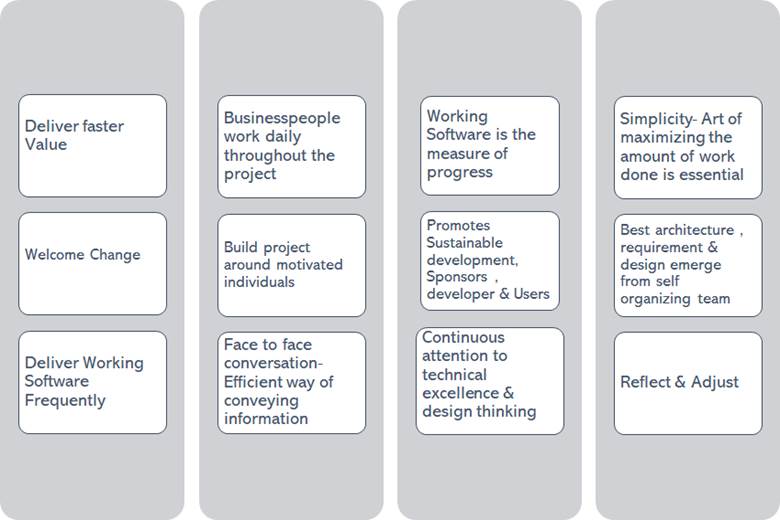The Agile Way – A Strategic Move of Planning by Subex
Why Agile?
Agile methodology is based on 4 values and 12 principles.
Agile values: It explores better ways of developing software
- Individual interactions over processes and tools
- People and interactions are valued.For instance: In estimation work, we value interaction and conversation more than the actual estimate.
- Working software over comprehensive documentation
- Create a shared understanding by having more conversations with the stakeholders
- Customer collaboration over contract negotiation
- Collaborate more with the customer. Work with the customer and client throughout the project to create a win-win situation.
- Responding to change over following a Plan
- We need to be able to respond to change as they happen in complex situations.
What are the 12 principles of Agile project management?

SCRUM | KANBAN|SCRUMBAN
The framework follows different AGILE Methodologies which can continuously improve the product, team, and working environment.
- SCRUM- Framework which lets us execute different AGILE Processes, SCRUM can continuously improve the product, team, and working environment. SCRUM framework consists of associated roles, artifacts, events, and rules.
- KANBAN– It works on lean principles; it helps deliver orders continuously with efficient use of resources. It is simply whiteboards, paper cards, or post-it notes.
- SCRUMBAN– It’s a hybrid of Scrum and Kanban. Scrumban is an Agile management methodology that is a hybrid of Scrum and Kanban. The name Scrumban comes as a combination of [Scrum + (Kan)ban]. Scrumban was developed to make it easier for existing Scrum teams to transition to Kanban and explore lean methodologies.
- Scrumban combines the structure of Scrum with the flow-based methods and visualization of Kanban.
Features of the methodologies
| Features | SCRUM | KANBAN | SCRUMBAN |
| Rule | Very descriptive | Not descriptive | Descriptive |
| Board | Reset of each sprint | Used Continuously | Used Continuously |
| Role | Scrum Master, Product Owner & the team | Specialized team | Specialized team |
| Iteration | 1-4 weeks sprint | Need based | Need based |
| Planning | Sprint Planning | On-demand & release planning | On-demand & release planning |
| Task estimation | Done before each sprint | During planning (Optional) | Optional |
| Task assignment | Assigned to the team | Taken by team members | Taken by team members |
| Prioritization | By Refining Backlog | By priority columns | By Priority Columns |
| Task Limits | Limited by Sprints | Limited by WIP | Limited by WIP |
| Meeting | Planned & Mandatory | On-demand & Optional | On-demand & Optional |
| Performance Metrics | Burndown Chart | Lead & Cycle time Cumulative flow | Lead & Cycle time Average Cycle time |
Waterfall and Agile: The key differentiators
Waterfall methodology has been followed for ages where project deliverables occurred in succession. In the waterfall development project, each of these represents a distinct stage of software development, and each stage generally finishes before the next one can begin.
There is also typically a stage gate between each; for example, requirements must be reviewed and approved by the customer before design can begin.
The key differentiators:
| Waterfall | Agile |
| Deliver result only at end of the project | Deliver result early & often continuously |
| Perfect for long term projects | Perfect for IT & SW Projects |
| Change must be managed & controlled; it impacts projects negatively | Enable Change more easily on projects |
| End project is defined & fixed | Support changing request either in market or technologies |
| Deliver by task in succession | Deliver in sprints |
The benefits of Agile methodology
We all are aware by now AGILE delivers value on an incremental basis. It does match the dynamic business requirement. However, it does come with certain challenges. The possible challenges with respect to using AGILE include:
- It changes the Org Structure
- Teams need to be reframed
- It works heavily on collaboration and needs less documentation
The key Agile metrics
Although the specific criteria to look for will vary depending on the size, maturity, and goals of your organization, be sure that your Agile software solution includes the following aspects:
- Visual management
- Lean and Agile metrics
- Hierarchical structure
- Ability to integrate with existing tools
- Enables communication
- Easy to update and interact with
The flow of Agile Methodology
How Subex uses the Agile process to drive customer success?
Subex has adopted a hybrid model of delivery to assess the requirements and deliver the project on or before the stipulated duration. A significant benefit Subex is experiencing on account of the transition from Waterfall to Agile is Revenue Realization into the corresponding Sprints. Here are some of the key benefits:
- More Focus
- Reduced Cost
- More Transparency
- Better Quality
- High Productivity
Agile methods generally allow for faster iteration and more frequent releases with subsequent user feedback that can be worked into future development. Waterfall methods tend to greatly lessen the number and severity of errors that will affect the end-user.
So, in many cases, the optimum project combination incorporates significant planning and QA input early in the development process to mitigate errors while introducing Agile processes to the release schedule and user feedback opportunities, allowing for faster and more controlled improvements.
At Subex, our customers are at the heart of everything we do, and we utilize every opportunity to empower them to succeed. Our agile approach enables our customers with the speed, agility, and rapid innovation required to get the desired business results. With a structured and iterative agile approach, we, at Subex are committed to delivering winning solutions that inspire trust and help our customers succeed.
Want to know how we empower leading telecom operators to drive growth? Get in touch with us!




